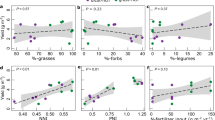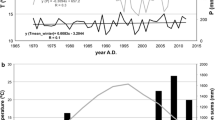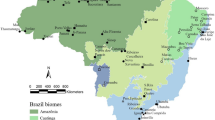Abstract
Annual or biannual time courses of plant δ13C (δ13Cp) over the last century (70–100 years) were recorded for leafbases of four grasstrees (Xanthorrhoea preissii) at four sites in mediterranean Australia and wood of four conifers (Widdringtonia cedarbergensis) at two sites in mediterranean South Africa. There was a strong downward trend of 2–5.5‰ from 1935 to 1940 to the present in the eight plants. Trends were more variable from 1900 to 1940 with plants at two sites of each species showing an upward trend of 1–2.5‰. Accepting that δ13C of the air (δ13Ca) fell by almost 2‰ over the last century, the ratio of leaf intercellular CO2 to atmospheric CO2 (c i/c a) rose in five plants and remained unchanged in three over that period. Changes in c i/c a rather than δ13Ca were more closely correlated with changes in δ13Cp and accounted for 6.7–71.8% (22.6c i/c a) and 28.2–93.3% (δ13Ca) of the variation in δ13Cp. We doubt that possible changing patterns of rainfall, water availability, temperature, shade, air pollution or clearing for agriculture have contributed to the overall trend for c i/c a to rise over time. Instead, we provide evidence (concentrations of Fe and Mn in the grasstree leafbases) that decreasing photosynthetic capacity associated with falling nutrient availability due to the reduced occurrence of fire may have contributed to rising c i/c a. Intrinsic water-use efficiency (W i) as a function of (c a–c i) usually increased linearly over the period, with the two exceptions explained by their marked increase in c i/c a. We conclude that grasstrees may provide equivalent δ13Cp and W i data to long-lived conifers and that their interpretation requires a consideration of the causes of variation in both c i/c a and δ13Ca.



Similar content being viewed by others
References
Bert D, Leavitt SW, Dupouey J-L (1997) Variations of wood δ13C and water-use efficiency of Abies alba during the last century. Ecology 78:1588–1596
Colangelo WI, Lamont BB, Jones AS, Ward DJ, Bombardieri S (2002) The anatomy and chemistry of the colour bands of grasstree stems (Xanthorrhoea preissii) as a basis for plant age and fire history determination. Ann Bot 89:606–611
Crombie DS, Tippett JT, Hill TC (1988) Dawn water potential and root depth of trees and understorey species in south-western Australia. Aust J Bot 36:621–631
Davison EM (1997) Are jarrah (Eucalyptus marginata) trees killed by Phytophthora cinnamomi or waterlogging? Aust For 60:116–124
Duddwiddie PW, La Marche VC Jr (1980) A climatically responsive tree-ring record from Widdringtonia cedarbergensis, Cape Province, South Africa. Nature 286:796–797
Duquesnay AN, Bréda M, Stievenard M, Dupouey JL (1998) Changes of tree-ring δ13C and water-use efficiency of beech (Fagus sylvatica L.) in north-eastern France during the past century. Plant Cell Environ 21:565–572
Ehleringer JR, Hall AE, Farquhar GD (eds) (1993) Stable isotopes and plant carbon-water relations. Academic Press, San Diego
Farquhar GD, Richards RA (1984) Isotopic composition of plant carbon correlates with water-use efficiency of wheat genotypes. Aust J Plant Physiol 11:539–552
Farquhar GD, O'Leary MH, Berry JA (1982) On the relationship between carbon isotope discrimination and the intercellular carbon dioxide concentration in leaves. Aust J Plant Physiol 9:121–137
Farquhar GD, Ehleringer JR, Hubick KT (1989) Carbon isotope discrimination and photo-synthesis. Annu Rev Plant Physiol Plant Mol Biol 40:503–537
February EC, Stock WD (1999). Declining trend in the 13C/12C ratio of atmospheric carbon dioxide from tree rings of South African Widdringtonia cedarbergensis. Q Res 52:229–236
Feng X (1998) Long-term c i/c a response of trees in western North America to atmospheric CO2 concentration derived from carbon isotope chronologies. Oecologia 117:19–25
Feng X (1999) Trends in intrinsic water-use efficiency of natural trees for the past 100–200 years: a response to atmospheric CO2 concentration. Geochim Cosmochim Acta 63:1891–1903
Feng X, Epstein S (1995) Carbon isotopes of trees from arid environments and implications for reconstructing atmospheric CO2 concentration. Geochim Cosmochim Acta 59:2599–2608
Flanagan LB, Ehleringer JR (1998) Ecosystem-atmosphere CO2 exchange: interpreting signals od change using stable isotope ratios. Trends Ecol Evol 13:10–14
Francey RJ, Farquhar GD (1982) An explanation of 13C/12C variations in tree rings. Nature 297:28–31
Freyer HD (1979) On the 13C record in tree rings. I. 13C variations in northern hemispheric trees during the last 150 years. Tellus 31:124–137
Friedli H, Lötscher H, Oeschger H, Siegenthaler U, Stauffer B (1986) Ice core record of the 13C/12C ratio of atmospheric CO2 in the past two centuries. Nature 324:237–239
Hughes L (2000) Biological consequences of global warming: is the signal already apparent? Trends Ecol Evol 15:56–61
Lamont BB, Downes S (1979) The age, flowering and fire history of the grasstrees Xanthorrhoea preissii and Kingia australis. J Appl Ecol 16: 893-899
Lamont BB, Groom PK, Cowling RM (2002) High leaf mass per area of related species assemblages may reflect low rainfall and carbon isotope discrimination rather than low phosphorus and nitrogen levels. Funct Ecol 16:403–412
Lamont BB, Ward DF, Eldridge J, Korczynskyj D, Colangelo WI, Fordham C, Clements E, Wittkuhn R (2003) Believing the Balga: a new method for gauging the fire history of vegetation using grasstrees. In: Abbott I, Burrows N (eds) Fire in south-west Western Australian ecosystems: impacts and management. Backhuys, Leiden, The Netherlands, pp 146–169
Leavitt SW, Long A (1992) Altitudinal differences in δ13C of bristlecone pine tree rings. Naturwissenschaften 79:178–180
Marshall JD, Monserud RA (1996) Homeostatic gas-exchange parameters inferred from 13C/12C in tree rings of conifers. Oecologia 105:13–21
Marschner H (1995) Mineral nutrition of higher plants. Academic Press, San Diego
Pearman GI, Francey RJ, Fraser PJB (1976) Climatic implications of stable isotopes in tree rings. Nature 260:7713
Pita P, Soria F, Cañas I, Toval G, Pardos JA (2001) Carbon isotope discrimination and its relationship to drought resistance under field conditions in genotypes of Eucalyptus globulus Labill. For Ecol Manage 141:211–221
Podani J (1995) SYNTAX 5.02. Mac user's guide. Scientia, Budapest
Sealy JC (1986) Stable isotopes and prehistoric diets in the south-western Cape Province, South Africa. BAR International Series 293. Oxford University Press, Oxford
Staff IA, Waterhouse JT (1981) The biology of arborescent monocotyledons, with special reference to Australian species. In: Pate JS, McComb AJ (eds) The biology of Australian plants. University of Western Australia Press, Nedlands, pp 216–257
Stuiver M, Burk RL, Quay PD (1984) 13C/12C ratios in tree rings and the transfer of biospheric carbon to the atmosphere. J Geophys Res 89:11731–11748
Tans PP, Mook WG (1980) Past atmospheric CO2 levels and the 13C/12C ratios in tree rings. Tellus 32:268–283
Ward DJ, BB Lamont, CL Burrows (2001). Grasstrees reveal contrasting fire regimes in eucalypt forest before and after European settlement of southwestern Australia. For Ecol Manage 150:323–329
Acknowledgements
The work was supported by the Australian Research Council (Linkage), Department of Conservation and Land Management (Western Australia), the South African Water Research Commission and National Research Foundation (South Africa). The assistance of David Ward, Chantal Burrows and Lidia Bednarek, and advice of John Pate, Pauline Grierson and Mark Adams were much appreciated. We thank Christian Koerner and the referees for their comments.
Author information
Authors and Affiliations
Corresponding author
Appendix
Appendix
Calculation steps
-
Step 1. Calculate c a:
(Feng 1998).
-
Step 2. Calculate carbon isotope discrimination by the plant:
(Feng 1999, citing Farquhar et al. 1989).
-
Step 3. Calculate c i using Δ13 and c a above:
(Feng 1998).
-
Step 4. Finally, calculate W i using c a and c i above:
Rights and permissions
About this article
Cite this article
Swanborough, P.W., Lamont, B.B. & February, E.C. δ13C and water-use efficiency in Australian grasstrees and South African conifers over the last century. Oecologia 136, 205–212 (2003). https://doi.org/10.1007/s00442-003-1263-y
Received:
Accepted:
Published:
Issue Date:
DOI: https://doi.org/10.1007/s00442-003-1263-y




